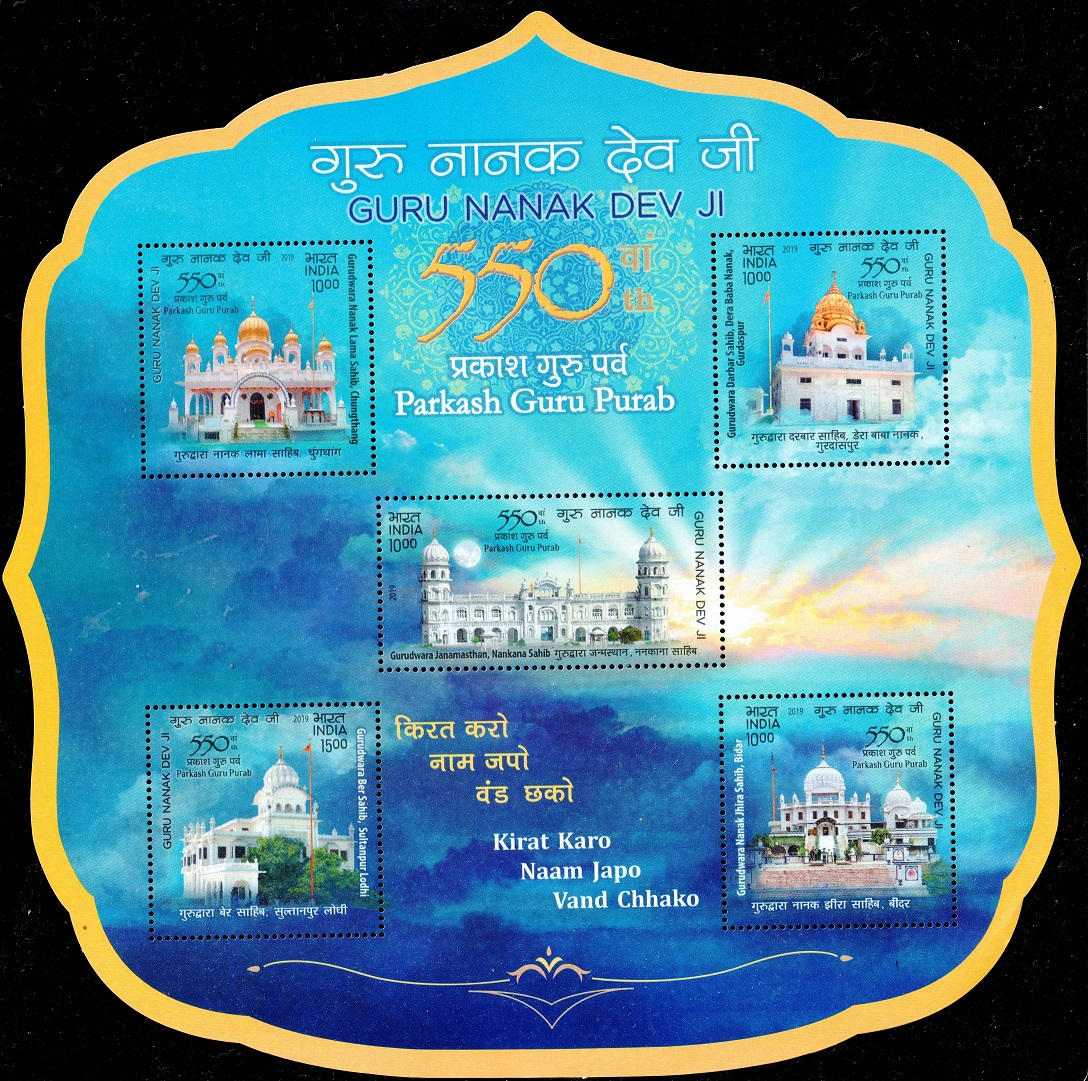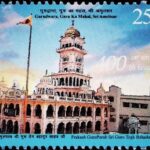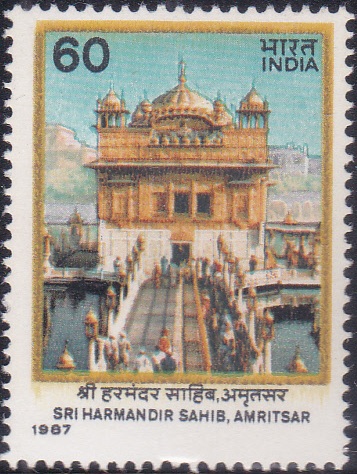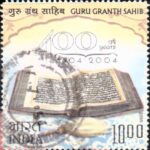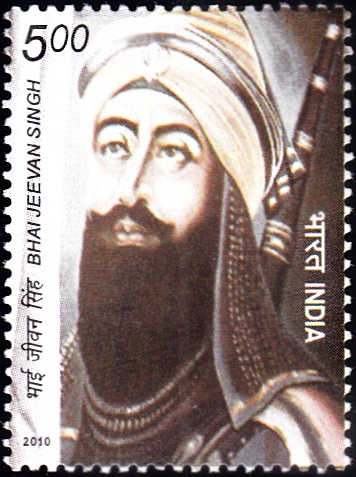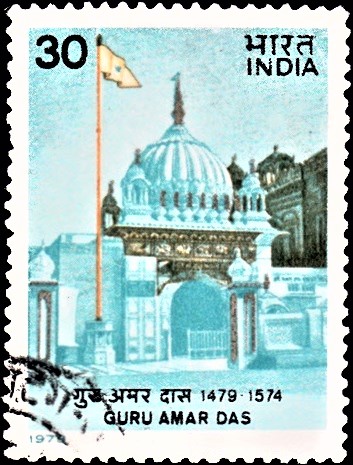
Guru Amar Das
A commemorative postage stamp on the 500th Birth Anniversary of Guru Amar Das, 3rd of the Ten Gurus of Sikhism :
 Issued by India
Issued by India
Issued on Dec 21, 1979
Issued for : The Posts & Telegraphs Department feels privileged to issue a commemorative stamp to mark the occasion of the 500th birth anniversary of Guru Amar Das.
Description of Design : The design of the stamp shows Gurdwara Baoli Sahib, Goindwal, Amritsar District.
Type : Stamp, Postal Used
Colour : Multicolour
Denomination : 30 Paise
Overall size : 3.91 X 2.90 cms.
Printing size : 3.55 X 2.54 cms.
Perforation : 13 X 13
Watermark : Printed on coated adhesive stamp paper
Number printed : 50,00,000
Number per issue sheet : 35
Printing process : Photogravure
Designed and printed at : India Security Press
Name : Amar Das
Born on May 5, 1479 at Basarke village, Amritsar district, Punjab, India
Died on Sep 1, 1574 at Goindval, Punjab, India
About :
- From the One Lord
Have come forth all different forms, shapes and hues.
— Guru Amar Das, the Guru Granth Sahib, p. 160 - 1979 marks the quincentenary of the birth of Guru Amar Das, a spiritual teacher with a rare mystical insight and wide human sympathy. He was one of the Ten Gurus or prophet-teachers of the Sikh faith. Third in line from Guru Nanak, the founder, he carried his teaching of universal love and equality of mankind to the far corners of India. He lived a simple and holy life. In personal humility and seva, deeds of self-giving love and service, he set standards scarcely equalled. He was a superb poet and wrote chaste Punjabi verse of deep spiritual intuition and of moral and humanitarian import. His bani, 907 sublime hymns, is still preserved in the Guru Granth Sahib, the sacred scripture of the Sikhs.
- Guru Amar Das inherited the light from Guru Angad, the Second Guru of the Sikh faith. He was his senior in age by 25 years, yet he proved to be a true disciple. He was born on May 5, 1479, at the village of Basarke, near Amritsar, and was the eldest of the four sons of Baba Tej Bhan. He shared the family’s religious zeal and year after year made pilgrimage to Hardwar to bathe in the sacred waters. This he did without fail until as he was once returning from his holy duty, he was reproached by a sadhu for not owning a Guru. Without a Guru or enlightener all his exertions, he was told, must remain abortive. Since that day Amar Das had been in search of a teacher.
- One day he happened to listen to the bani of Guru Nanak being recited. He felt enchanted and desired to see the Guru who sat in Guru Nanak‘s place. As he was escorted to Guru Angad‘s presence, he at once knew that he had found what he had been in search of. For him this was the beginning of a new life. He was old, yet he took to the teaching of the Guru with vigorous zeal. He performed his daily devotions and derived special joy from rendering service to the Guru. He brought water from the river every morning for his bath. He served food in the Guru-ka-Langar or community refectory and fetched firewood from the forest. His life was an example of humility and devotion. Guru Angad acknowledged the perfection he had achieved by proclaiming him the future Guru.
- Guru Amar Das entered upon the office of Guru on Guru Angad‘s passing away in 1552. To spread the message on Guru Nanak, he created a well-knit ecclesiastical system and set up 22 manjis, dioceses or preaching-districts, covering different parts of India. He appointed the first days of the months of Baisakh and Magh as well as Divali for the followers to gather at Goindwal which was his permanent seat of residence. Here at Goindwal he had a baoli, a well with 84 steps, dug and this became an important point of pilgrim interest. Guru Amar Das laid down simple ceremonies and rites for birth, marriage and death. He gave special attention to the amelioration of the position of women. The removal of the disadvantages to which they had been subject became an urgent concern. He assigned to women the responsibility of supervising the communities of disciples in certain sectors. The customs of purdah and sati were discouraged. The Guru-ka-Langar where all sat together to eat irrespective of the differences of caste and of high and low, gained still further renown in Guru Amar Das‘s time. The Guru expected every visitor to partake of food in it before seeing him. By this he meant to minimize the distinctions between man and man. Emperor Akbar, who once visited him at Goindwal, willingly ate out of the common kitchen. The food in the langar was usually of a rich Punjabi variety. Guru Amar Das himself, however, lived on coarse bread earned by the labour of his hands.
- The bani, the Guru‘s revealed word, continued to be the precious endowment. Guru Amar Das himself composed verse of vivid spiritual insight. He also collected the compositions of his predecessors and of some of the Bhaktas of that time. When he compiled these into two volumes – both preserved in the descendant family to this day – an important step towards the codification of the Sikh canon had been taken.
- Guru Amar Das now desired to name a successor. None was worthier of the holy responsibility than Bhai Jetha, one of the Guru‘s devoted disciples. He made several tests and each time his confidence in Bhai Jetha was enhanced. He was convinced that of all of his disciples, Bhai Jetha had mastered the teaching of Guru Nanak most worthily. He judged him suitable for the position of Guru and consecrated him as such by his own hand. Jetha, as Guru Ram Das became the Fourth Guru of the Sikhs. As the bards sang, “He was Nanak, He was Lahna (Angad), He was Amar Das himself”. So was he acknowledged after Guru Amar Das who blended his light with Light Eternal on 1 September 1574.


